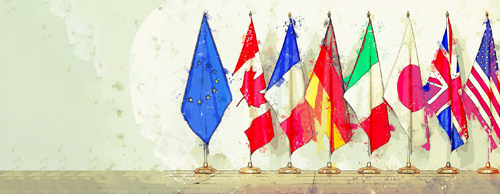The risks of a renewed format
The G7 must tread a fine line between being more inclusive and participatory, and upholding the group’s value and unique position in the overall global governance landscape – a necessary critical balance if the G7 is to remain relevant and effective, says Tristen Naylor, fellow in international relations, London School of Economics
France has declared a ‘renewed format’ for the G7, prioritising engagement with non-members. The club needs to be careful, though, not to repeat past mistakes in widening participation or undermine its role in the overall global governance landscape.
France has invited eight countries to join the G7 in Biarritz: Australia, Chile, India, South Africa, Burkina Faso, Egypt, Senegal and Rwanda, in addition to holding outreach initiatives with civil society, including the Gender Equality Advisory Council and the G7’s nine engagement groups. This brings the G7 far from France’s original design for the summit in 1975 as an intimate ‘fireside chat’ among the leaders of France, Britain, Western Germany, Italy, the United States and Japan.
Indeed, much of the club’s early history involved resisting additional participants, with only Italy and Canada making it into the group over the particular reluctance of France. Such reticence also marked the disputed incorporation of Russia in the 1990s and drove the push for a back-to-basics format at the 2012 Camp David Summit following years of bloated guest lists, the high watermark of which saw Italy issue 28 invitations to the 2009 L’Aquila Summit. This pause in expanded participation did not last long – after Russia’s suspension in 2014, successive hosts again began liberally extending invitations. In 2018, Canada invited 16 non-members to the Charlevoix Summit.
This year’s summit format thus indicates the expansionary impulse with which the club has always wrestled. The reasons behind it are good: engagement helps buttress the multilateral order, keeps non-traditional issues at the top of the governance agenda and shores up legitimacy for the western-focused club. Moreover, such a coalition is particularly critical as the international community confronts the challenges that top the G7’s agenda.
Free and frank exchange
Despite just intentions and pressing needs, articulating the G7 in this way might actually create problems. First and foremost, an expanded guest list reduces the efficacy of meetings. The more people around the table, the less free-flowing conversation there tends to be. This was a central concern of the first summit host, Valéry Giscard d’Estaing, motivating him to keep the group as small as possible, and it likewise inspired smaller summits in more recent years. The intimacy of these meetings has allowed the G7 to maintain its edge since the advent of the G20, remaining a setting conducive to free and frank exchange rather than formal, prepared statements. The larger and more cumbersome the G7 process becomes, while improving its credentials as an inclusive, participatory forum, the less it can successfully operate as a driver of global governance.
The second problem is that of duplication. The world already has a more inclusive, participatory informal governance forum in the G20. Three of the Biarritz invitees are G20 members (Australia, India and South Africa), Senegal is regularly invited to the G20, and Egypt and Rwanda also have sat at the G20 table. The panoply of civil society engagement groups likewise recreates what the G20 has already pioneered.
Third, in addition to encumbering the club, the potential effects of this arrangement are dampened by there being less incentive for invitees to participate as robustly as they otherwise would as full members, as is particularly the case for G20 members Australia, India and South Africa. Moreover, the initiatives that filter through engagement processes are more likely to be implemented globally via the G20, where China, Brazil, Indonesia and Russia have a stake. This is a lesson that the club ought to have learned from its ‘Outreach’ process after 2005, when China, India, Brazil, South Africa and Mexico were invited to G8 summits. That initiative was not without resentment, marking the invitees with the status of second-tier add-ons, and was unsurprisingly abandoned with the elevation of the G20 to the leaders’ level, where they sit at the table as equals.
The motivations for a more inclusive and participatory G7 are both laudable and necessary. But such expansion has the potential to undermine the club’s added value and unique position in the overall global governance landscape. Managed well, this renewed format can help keep the G7 relevant and effective; managed poorly, it could further weaken the case for there being a G7 at all.












